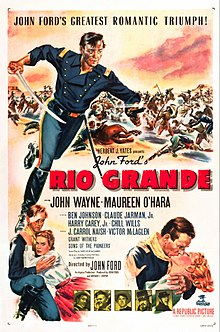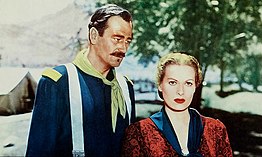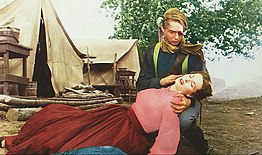Rio Grande (1950 film)
| Rio Grande | |
|---|---|
 Theatrical poster | |
| Directed by | John Ford |
| Screenplay by | James Kevin McGuinness |
| Based on | Mission With No Record 1947 story Saturday Evening Post by James Warner Bellah |
| Produced by | Uncredited: Merian C. Cooper John Ford |
| Starring | |
| Cinematography | Bert Glennon |
| Edited by | Jack Murray |
| Music by | Victor Young |
Production companies | |
| Distributed by | Republic Pictures |
Release date |
|
Running time | 105 minutes |
| Country | United States |
| Language | English |
| Budget | $1,214,899[1][2] |
| Box office | $2.25 million (US rentals)[3] |



Rio Grande is a 1950 American romantic Western film[4][5] directed by John Ford and starring John Wayne and Maureen O'Hara. It is the third installment of Ford's "Cavalry Trilogy", following two RKO Pictures releases: Fort Apache (1948) and She Wore a Yellow Ribbon (1949).[6] Wayne plays the lead in all three films, as Captain Kirby York in Fort Apache, then as Captain Nathan Brittles in She Wore a Yellow Ribbon, and finally as a promoted Lieutenant Colonel Kirby Yorke in Rio Grande.[a] Rio Grande's supporting cast features Ben Johnson, Claude Jarman Jr., Harry Carey Jr., Chill Wills, J. Carrol Naish, Victor McLaglen, Grant Withers, the Western singing group the Sons of the Pioneers and Stan Jones.
Plot
[edit]In the summer of 1879, Lieutenant Colonel Kirby Yorke (Wayne) is posted on the Texas frontier with the 2nd U.S. Cavalry Regiment to defend settlers against attacks by marauding Apaches. Yorke has just captured the Apache's leader. Apaches have been using Mexico as a sanctuary from pursuit, and the regiment is suffering from a serious shortage of troops under Yorke's command.
Yorke has been estranged from his wife and son for 15 years, after he set fire to his wife's plantation under orders from his commander during the Civil War. Yorke's son, Trooper Jefferson Yorke (Claude Jarman Jr.), is one of 18 recruits sent to the regiment. After failing mathematics and flunking out of West Point, he immediately enlisted as a private in the Army. In a meeting with his father, Yorke informs him that he will receive no special treatment in the brutal way of life he has chosen; Jeff declares he wants none. Through his willingness to undergo any test or trial, Jefferson befriends Travis Tyree (Ben Johnson) (who is on the run from the law) and Daniel "Sandy" Boone (Harry Carey Jr.). Yorke's estranged wife, Kathleen (Maureen O'Hara), arrives unexpectedly to buy the underage Jefferson out of his enlistment. In a showdown with his mother, Jeff refuses her attempt to buy him out of the Army. The struggle over their son's future rekindles the romance the couple once felt for each other.
The Apaches attack the fort one night. Many of them are killed by the awakened troopers, but they succeed in freeing their leader. When Yorke's patrol reaches the Rio Grande, too late to capture the Apaches he was following, he meets a Mexican patrol. They exchange cordialities and both confirm that the US troops cannot cross into Mexico. Yorke is visited by his former Civil War commander, Philip Sheridan (J. Carrol Naish), now Commanding General of the Military Division of the Missouri, the headquarters responsible for pacifying the Great Plains. Sheridan has decided to order Yorke to cross the Rio Grande into Mexico in pursuit of the Apaches and kill them all, an action with serious political implications, since it violates the sovereignty of another nation. Sheridan, promises that if Yorke faces court-marshalling, will ensure that the members of the court are his fellow soldiers from the Civil War. Yorke accepts the assignment.
Before Yorke leads his men toward Mexico, he sends the women and children to Ft. Bliss for safety, with an escort including Jefferson. Jefferson and Boone meet Tyree, who is hiding from the law. Tyree informs them that there are Apaches in the area. The Apaches attack the wagons and capture the one carrying the children and corporal Bell's wife. While the remaining escort fends off the Apache, Jefferson returns to the fort for reinforcements. Tyree saves him from an Apache attack on the way back.
The regiment meets the survivors of the escort and follows the Apache. They discover the burnt-out wagon and the body of corporal Bell's dead wife, but there is no sign of the children. In the meantime, Tyree rejoins the regiment and tells them he trailed the Apaches to their hideout in Mexico. Working with Tyree, Yorke permits three troopers, Tyree, Boone, and Jefferson, to infiltrate where the Apaches have taken the children. Then Yorke leads his regiment in an all-out attack. The cavalrymen rescue all of the children unharmed, though Colonel Yorke is wounded by an arrow that he orders Jeff to remove. He is taken back to the fort by his victorious troops, where Kathleen meets him and holds his hand as he is carried on a travois into the post.
After Colonel Yorke recovers, Tyree, Boone, Jeff, Navajo Scout Son of Many Mules, and Corporal Bell are decorated. At the ceremony, when one of the Texas marshals reappears, Trooper Tyree is given a furlough to continue his run from the law, stealing General Sheridan's horse for the purpose. As the troops pass in review, the regimental band plays Dixie at the General's request, apparently to please Mrs. Yorke.
Cast
[edit]
- John Wayne as Lieutenant Colonel Kirby Yorke
- Maureen O'Hara as Kathleen Yorke
- Ben Johnson as Trooper Travis Tyree
- Claude Jarman Jr. as Trooper Jefferson Yorke
- Harry Carey Jr. as Trooper Daniel "Sandy" Boone
- Chill Wills as Dr. Wilkins, Regimental Surgeon
- J. Carrol Naish as General Philip Sheridan
- Victor McLaglen as Sergeant Major Quincannon
- Grant Withers as Deputy Marshal
- Sons of the Pioneers as the Regimental Singers
- Ken Curtis as the lead singer of the Regimental Singers
- Shug Fisher as Regimental Singer and regimental bugler
- Peter Ortiz as Captain St. Jacques
- Steve Pendleton as Captain Prescott
- Karolyn Grimes as Margaret Mary
- Alberto Morin as Mexican Lieutenant
- Stan Jones as Sergeant
- Fred Kennedy as Trooper Heinze
Production
[edit]Background
[edit]With the completion of Wagon Master, Ford did not want to make another Western. Instead, he wanted to film the Ireland-set romantic comedy-drama film The Quiet Man with Wayne and Maureen O'Hara, but Herbert Yates, the studio president of Republic Pictures, insisted that Ford first make Rio Grande with the same pairing of Wayne and O'Hara because he thought the script of The Quiet Man was weak and that the story was of little general interest. Yates insisted that Rio Grande be made before The Quiet Man, to offset the anticipated losses on that film.[8][2] When The Quiet Man was eventually released in 1952, though, it vastly out performed Rio Grande by grossing $3.8 million in its first year and giving Yates and Republic Pictures one of the top-10 hits of the year.[9]
Writing
[edit]The script for Rio Grande was written by Irish-born screenwriter James Kevin McGuinness. It is based on a short story "Mission With No Record" by James Warner Bellah that appeared in The Saturday Evening Post on September 27, 1947.[10] Parts of the story loosely resemble the expedition of the 4th Cavalry Regiment (United States) under Colonel Ranald S. Mackenzie when they conducted a military campaign in Mexico in 1873.[11] McGuinness based his story on a specific raid from May 1873 where Colonel Ranald Mackenzie, under orders from General Phil Sheridan, crossed the border to fight Kickapoo people, and kidnapped some of their women and children to hold as hostages. This was illegal.[12] During filming, the film was called Rio Bravo and then Rio Grande Command until right before release.[13]
Casting
[edit]Skilled stuntman and rodeo star Ben Johnson played his third credited role in Rio Grande. The stunt where he rides two horses "Roman style", standing on the backs of two separate horses, took three weeks to master.[14]
Rio Grande was the first of three films directed by Ford starring the pairing of John Wayne and Maureen O'Hara, followed by The Quiet Man in 1952[15] and The Wings of Eagles in 1957. Wayne and O'Hara also starred together in McLintock! (1963) and Big Jake (1971).
Filming
[edit]The film was shot entirely on location in Moab, Utah, during the extremely hot summer of 1950. Cast and crew struggled with the heat. Sets and stages had to be built in the difficult conditions, while actors were required to perform their scenes in heavy period costumes.[16][better source needed]
The location shoot was a prime example of Ford's legendary efficiency—according to Ford scholar Tag Gallagher, Rio Grande was shot in just 32 days, with only 352 takes from 332 camera setups.[citation needed][13]
Music
[edit]The film contains folk songs led by the Sons of the Pioneers, one of whom is Ken Curtis (Ford's son-in-law).[17][18] A reviewer in The New York Times wrote that the music was "mighty pleasant".[19]
Reception
[edit]A review by New York Times described it as a "familiar story" that "travels a well-rutted road" but that "the horsemanship never was better". It was also noted for its similarities to the 1935 epic-adventure film The Lives of a Bengal Lancer. Praise was given, though, for the Western-style ballads sung by the Sons of the Pioneers.[19]
On Rotten Tomatoes the film has a 71% rating based on reviews from 17 critics.[20]
In a 2017 book on Wayne and Ford's films and friendship, Nancy Schoenberger conceded that Ford considered Rio Grande a "throwaway" film and that critics consider it the weakest of the Cavalry trilogy. Schoenberger wrote that the film "may be the most beautiful and most compelling" because of its setting.[21] She noticed that the relationship between Yorke and his abandoned son Jeff characterized by on-screen pain. Yorke allows a fistfight between Jeff and a stronger man to continue so Jeff can try to prove himself. Jeff loses the fight. Later, when Yorke is shot by an Apache arrow, he asks Jeff to take it out, "a feat that takes physical strength and an unflinching ability to inflict pain on a loved one in order to save his life."[22]
Themes
[edit]In a biography of John Wayne, authors Randy Roberts and James S. Olson analyze the success of Rio Grande, again alluding to consensus that it was the weakest film in the cavalry trilogy. They related the film's central conflict of "the frustration of diplomatic niceties and the untenable nature of borders" to the beginning of the Korean War, which involved American soldiers defending against Chinese attackers in North Korea. In the film, the frustration is resolved by attacking Apaches in Mexico. Roberts and Olson wrote that this solution reflected the conservative politics of Bellah and McGuinness, who believed that America's enemies who kill innocent people should be pursued into neutral countries if they take refuge there.[2] In a book on Ford, Wayne, and Ward Bond, Scott Allen Nollen also noticed that Rio Grande's "reactionary attitude toward Apaches as simplistic savages reflecting [...] arch-conservative views of McGuinness.[12] In a biography of John Ford, Joseph McBride saw Rio Grande as an "early-warning allegory of the Korean War" that expressed Ford's "anti-Communist feelings".[13]
The depiction of Native Americans in Rio Grande was very negative. Frank Nugent had previously written scripts for Ford's westerns, and his treatment of Native Americans was sympathetic. McGuinness, in contrast, was not. Joseph Breen, acting under the Production Code Administration said the script was "blatantly racist" and asked the producers to cut some of the more egregious lines, which they did. While the description of the Apache as "a scourge" was purged, the violent actions of the Apache remained in the film.[13]
Rio Grande, while a western, involves family drama, which is unusual in a genre associated with male friendship and mobility. Russell Meeuf, a journalism professor at the University of Idaho, wrote on 1950s masculinity in the Cavalry trilogy[23][24] McBride called it Ford's first "mature love story," where the "emotionally complex family drama [...] elevat[es] Rio Grande above its crudely racist and stridently jingoistic military plot." He saw Ford's sensitive treatment of Jeff as a possible sign of "self-recrimination over his coldhearted treatment of Pat" (Ford's own son). The ending of the film shows Kathleen performing household chores and waiting with the other wives to show that she is returning to stay with Yorke, which McBride calls "emotionally compelling despite its (qualified) sexism."[13] When Yorke returns, injured on a stretcher, Kathleen publicly walks alongside him, holding his hand, making her decision to stay with him one that includes the entire fort community, where women share in suffering while their husbands fight.[25] While the Kathleen's role is limited, she still represents a greater feminine presence than in many other westerns, such as those by Howard Hawks, Anthony Mann, or John Sturges.[26] Rio Grande's western family drama shows, for Meeuf, "the dynamic tensions of the balance between masculine adventurism and a settled domestic existence".[24]
Meeuf also looks at the treatment of class in the Cavalry trilogy. Kathleen initially wants to take her son back home with her so that he can be tutored in mathematics (the subject he failed) and return to West Point, where he can get a commission as an officer. This represents her expectations for her son as an upper-class woman. Yorke calls this attitude "special privilege for special born," and he prefers that their son Jeff work his way up from an enlisted officer by proving himself as a man and soldier. Kathleen yields to his preference, although for Meeuf, this "borders on the far-fetched." Still, the rejection of class privilege for the adventure of life in the West is a common theme in Ford's work.[27]
Accolades
[edit]The film was recognized by the American Film Institute in 2008: AFI's 10 Top 10: Nominated Western film. It was one of 50 films nominated for the top 10 best Westerns.[28]
See also
[edit]References
[edit]- ^ Flynn, Charles; McCarthy, Todd (1975). "The Economic Imperative: Why Was the B Movie Necessary?". In Flynn, Charles; McCarthy, Todd (eds.). Kings of the Bs: working within the Hollywood system: an anthology of film history and criticism. E. P. Dutton. p. 30.
- ^ a b c Roberts, Randy; Olson, James S. (1995). John Wayne: American. The Free Press. pp. 322–324. ISBN 0029238374.
- ^ 'The Top Box Office Hits of 1950', Variety, January 3, 1951
- ^ Variety film review; November 8, 1950, page 6.
- ^ Harrison's Reports film review; November 4, 1950, page 176.
- ^ Wetta and Novelli 2006, p. 299.
- ^ Wetta and Novelli 2006, p. 315.
- ^ The Quiet Man 60th Anniversary Edition, Special Features: Maltin, Leonard, "The Making of The Quiet Man", 1992; Schoenberger 2017, p. 90
- ^ Gallagher, Tag (1986). John Ford: The Man and his Films. University of California Press. p. 499. ISBN 9780520050976.
- ^ Wetta and Novelli 2006, pp. 307, 317.
- ^ Wetta and Novelli 2006, p. 305.
- ^ a b Nollen, Scott Allen (2013). Three Bad Men: John Ford, John Wayne, Ward Bond. McFarland. p. 211. ISBN 9780786458547.
- ^ a b c d e McBride, Joseph (2011). Searching for John Ford. Jackson: University Press of Mississippi. pp. 502–505. ISBN 9781604734683.
- ^ Schoenberger 2017, p. 96.
- ^ Schoenberger 2017, p. 90.
- ^ "John Ford's RIO GRANDE (1950)". www.aurorasginjoint.com. July 12, 2014.
- ^ Schoenberger 2017, p. 100.
- ^ Scott Eyman John Wayne: The Life and Legend 2015 -1439199590 Page 197: "Yates insisted that the Sons of the Pioneers appear in Rio Grande, which Ford found appalling, but he found a way to work them in as a sort of musical Greek chorus, cavalry style".
- ^ a b "THE SCREEN IN REVIEW; 'Rio Grande', a John Ford Film Starring John Wayne, Makes Its Bow at the Mayfair". New York Times. November 20, 1950.
- ^ "Rio Grande". Rotten Tomatoes. Retrieved March 18, 2022.
- ^ Schoenberger 2017, pp. 94–95.
- ^ Schoenberger 2017, pp. 100–101.
- ^ "Russell Meeuf: Professor". www.uidaho.edu. University of Idaho. Retrieved November 7, 2024.
- ^ a b Meeuf 2013, p. 68.
- ^ Meeuf 2013, p. 61.
- ^ Meeuf 2013, pp. 59.
- ^ Meeuf 2013, pp. 53–54.
- ^ "AFI's 10 Top 10 Nominees" (PDF). Archived from the original on July 16, 2011. Retrieved August 19, 2016.
{{cite web}}: CS1 maint: bot: original URL status unknown (link)
Works Cited
[edit]- Meeuf, Russell (2013). John Wayne's World: Transnational masculinity in the fifties. University of Texas Press. ISBN 9780292747470.
- Schoenberger, Nancy (2017). Wayne and Ford: The Films, Friendship, and the Forging of an American Hero. Doubleday. ISBN 9780385534857.
- Wetta, Frank J.; Novelli, Martin A. (June 2006). "'Romantic, isn't it, Miss Dandridge?': Sources and Meanings of John Ford's Cavalry Trilogy". American Nineteenth Century History. 7 (2).
Notes
[edit]External links
[edit]- Rio Grande at IMDb
- Rio Grande at AllMovie
- Rio Grande at the TCM Movie Database
- Rio Grande at the AFI Catalog of Feature Films
- 1950 films
- 1950 Western (genre) films
- 1950 romantic drama films
- American black-and-white films
- American Western (genre) films
- Films based on American short stories
- Films directed by John Ford
- Films scored by Victor Young
- Films set in 1879
- Films set in Texas
- Films shot in Utah
- Republic Pictures films
- Western (genre) cavalry films
- Apache Wars films
- 1950s English-language films
- 1950s American films
- English-language Western (genre) films
- English-language romantic drama films
